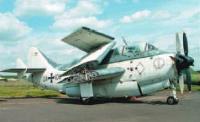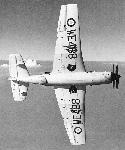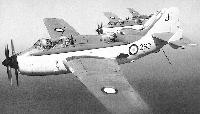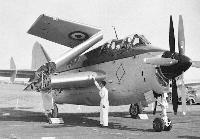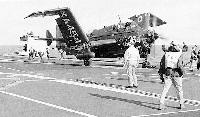
Описание
Страна : Великобритания
Год : 1949
Трехместный противолодочный палубный самолет
Варианты
- Fairey - Gannet - 1949 - Великобритания
- Fairey - Gannet AEW - 1958 - Великобритания
Fairey Gannet
В конкурсе на противолодочный/ударный палубный самолет по спецификации GR.17/45 приняли участие "Fairey" и "Blackburn", получившие заказы на постройку двух и трех прототипов соответственно. "Blackburn" представила прототипы Y.A.7 и Y.A.8 с поршневыми моторами Rolls-Royce Griffon, а также Y.A.5, разработанный под проектируемый турбовинтовой двигатель Napier Naiad. Из-за неготовности двигателя Y.A.5 переделали в Y.B.1 с ТВД Armstrong Siddeley Double Mamba. Fairey Gannet также проектировался под ТВД Double Mamba, имевший ряд преимуществ перед обычными силовыми установками: каждая "половинка" силовой установки управлялась независимо, что позволяло выполнять полет на одном работающем двигателе при выходе из строя второго, а также снижало расход топлива и увеличивало дальность полета на крейсерском режиме. Каждый из двигателей приводил во вращение четырехлопастный винт, винты вращались в противоположных направлениях, отчего не возникало асимметрии тяги, обычной для двухмоторных самолетов.
Прототип Gannet, известный тогда как Fairey 17, выполнил первый полет 19 сентября 1949 года, второй опытный самолет поднялся в воздух 6 июля 1950 года. Оба прототипа были двухместными, но постройка трехместной опытной машины была внесена в контракт. Трехместный самолет полетел в мае 1951 года, через два месяца после подписания контракта на серийное производство. В июне 1950 года первый прототип стал первым турбовинтовым самолетом, выполнившим посадку на корабль, это был авианосец "Илластриес". Полет первого серийного Gannet AS.Mk 1 состоялся в июне 1953 года, первые четыре серийные машины передали в 703-ю испытательную эскадрилью в апреле 1954 года. Первой строевой частью, получившей на вооружение Gannet, стала 826-я эскадрилья, сформированная в январе 1955 года.
Работы по ТВД Double Mamba привели к появлению варианта Mk 101 мощностью 3035 л. с., который был установлен на Gannet AS.Mk 4, сменивший AS.Mk 1 в производстве. Всего построено 255 самолетов вариантов Mk 1 и Mk 4, которыми заменили все состоявшие на вооружении авиации британских ВМС Firefly и Grumman Avenger.
Для обучения экипажей разработали Gannet T.Mk 2 и Gannet T.Mk 5 с двойным управлением и без убираемого обтекателя РЛС, представлявшие собой варианты AS.Mk 1 и AS.Mk 4. В прототип Gannet T.Mk 2 перестроили Gannet AS.Mk 1, всего построили 37 самолетов Gannet T.Mk 2 и восемь Gannet T.Mk 5.
<...>
ВМС ФРГ в 1958 году закупили 15 Gannet AS.Mk 4 и один Gannet T. Mk 5, на следующий год ВМС Индонезии заказали 18 Gannet AS.Mk 4 и T. Mk 5. Две эскадрильи авиации австралийских ВМС получили Gannet в августе 1955 года в Калдроузе, в Австралию самолеты прибыли на авианосце "Мельбурн". Всего австралийский флот получил 33 Gannet AS.Mk 1 и три Gannet T. Mk 2. Несколько Gannet сохранилось в музеях. Интересно, что в 1982 году один Gannet AEW. Mk 3 был приобретен частным покупателем из США.
ТАКТИКО-ТЕХНИЧЕСКИЕ ХАРАКТЕРИСТИКИ
Fairey Gannet AS.Mk 1
Тип: трехместный противолодочный палубный самолет
Силовая установка: один ТВД Armstrong Siddeley Double Mamba ASMD.1 Mk 100 мощностью 2950 л. с. (2200 кВт)
Летные характеристики: максимальная скорость на оптимальной высоте 500 км/ч; крейсерская скорость на оптимальной высоте 480 км/ч; практический потолок 7620 м; дальность 1066 км
Масса: пустого 6835 кг; максимальная взлетная 9798 кг
Размеры: размах крыла 16,56 м; длина 13,11 м; высота 4,18 м; площадь крыла 44,85 м2
Вооружение: боевая нагрузка массой до 907 кг в фюзеляжном отсеке, обычно две торпеды, глубинные бомбы или мины и до 16 27-кг НАР на внешней подвеске под крылом
- Описание
Фотографии
-
Мировая Авиация 125
Регистрационный номер: XA338 Gannet AS.Mk 1 из 815-й эскадрильи, авианосец "Арк Ройал", конец 1950-х годов.
-
Air Enthusiast 2006-05 / D.Willis - Fairey's Versatile Gannet /Post-war combat/ (1)
Регистрационный номер: WN404 Gannet AS.1 WN404 of 820 Squadron during its period on HMS 'Bulwark' in 1956/1957.
-
АвиаМастер 2000-04 / Г.Минский - Королевский пеликан. Палубный противолодочный самолет Фэйри "Гэнит" /Монография/
Регистрационный номер: XG790 "Гэнит" COD.4, 849-я эскадрилья FAA (британских Королевских ВВС), авиабаза Броуди, Пемброукшир, Великобритания.
-
Air Enthusiast 2006-07 / D.Willis - Fairey's Versatile Gannet /Post-war combat/ (2)
Регистрационный номер: XG798 Gannet AS.6 XG798 of 831 Squadron. It was written off on November 11, 1962.
-
АвиаМастер 2000-04 / Г.Минский - Королевский пеликан. Палубный противолодочный самолет Фэйри "Гэнит" /Монография/
Регистрационный номер: UA+115 "Гэнит"AS.4, Морская Авиационная Эскадра "Граф Цеппелин", ВМС ФРГ.
-
АвиаМастер 2000-04 / Г.Минский - Королевский пеликан. Палубный противолодочный самолет Фэйри "Гэнит" /Монография/
"Гэнит"T.2, Австралийские ВМС, авиабаза Наура, Новый Южный Уэльс, Австралия.
-
Air Enthusiast 2006-05 / D.Willis - Fairey's Versatile Gannet /Post-war combat/ (1)
Регистрационный номер: XD898 Gannet AS.4 XD898 of 816 Squadron, Royal Australian Navy, based at Nowra, New South Wales, 1967.
-
АвиаМастер 2003-03 / М.Жирохов, А.Котлобовский - Небесные войны Индонезии /Горячая точка/ (2)
Регистрационный номер: AS-13 Фэйри "Гэннет", состоявший на вооружении ВВС Индонезии в 1950-х годах.
-
Мировая Авиация 164
Регистрационный номер: WE488 [2] WE488, третий опытный Gannet, в полете с одним работающим двигателем. Антенна РЛС - выдвинута, хорошо видна двухместная вторая кабина, которая на серийных машинах не ставилась.
-
Мировая Авиация 164
Регистрационный номер: WN365 [5] На фотографии - опытный самолет Gannet T.Mk 2 (WN365) в окраске учебной машины (алюминиевый с желтыми полосами). Перед кабиной инструктора виден выдвижной перископ.
-
Aeroplane Monthly 1996-08 / A.Renwick - The sky was his canvas
Регистрационный номер: WN365 [5] WN365, the prototype Fairey Gannet T.2 trainer, powered by an Armstrong Siddeley Double Mamba 100 turboprop, photographed in September 1955.
-
Aeroplane Monthly 1976-07
Регистрационный номер: WN365 [5] Fairey Gannet WN365 (c/n F.9137) was the prototype T.2 dual trainer variant, converted from an A.S.1 which was built at Hayes as part of a batch of 100. This aircraft first flew on August 16, 1954, and had dual controls in the forward cockpits, the instructor occupying the rearmost of the two and being supplied with a retractable periscope.
-
Aeroplane Monthly 1979-02
Регистрационный номер: XA466 [3] COD Fairey Gannet AS4 XA466 of Headquarters Flight, 849 Squadron, based at Lossiemouth.
-
Aeroplane Monthly 1997-12 / M.O'Leary - Stateside seabird
Регистрационный номер: XT752 [6] -
Aeroplane Monthly 1997-12 / M.O'Leary - Stateside seabird
Регистрационный номер: XT752 [6] -
Aeroplane Monthly 1997-12 / M.O'Leary - Stateside seabird
Регистрационный номер: XT752 [6] -
Aeroplane Monthly 1997-12 / M.O'Leary - Stateside seabird
Регистрационный номер: XT752 [6] -
Aeroplane Monthly 1994-04 / 1994 UK Aircraft Collections and Museums Guide
Регистрационный номер: XG883 [4] Gannet XG883 in immaculate condition at the Wales Aircraft Museum.
-
Aeroplane Monthly 1997-12 / M.O'Leary - Stateside seabird
Регистрационный номер: XT752 [6] -
Air Enthusiast 2006-07 / D.Willis - Fairey's Versatile Gannet /Post-war combat/ (2)
Регистрационный номер: XT752 [6] Alongside the AEW.3s and COD.4s, 849 Squadron had a number of T.5s on strength, including XT752, originally the prototype T.2.
-
Aeroplane Monthly 1994-12 / M.Oakey - Grapevine
Регистрационный номер: XG888 [3] Lee-on-Solent Fairey Gannet XG888 is going to the Royal Australian Navy Museum. Sister aircraft XT572 is in Sotheby’s auction.
-
Авиация и Космонавтика 2014-09 / Знаменательные даты сентября в истории авиации
Регистрационный номер: UA+108 [2] -
Air Enthusiast 2006-07 / D.Willis - Fairey's Versatile Gannet /Post-war combat/ (2)
Регистрационный номер: UA+112 Former West German Navy UA+112 is preserved at the collection at Speyer
-
Air Enthusiast 2006-05 / D.Willis - Fairey's Versatile Gannet /Post-war combat/ (1)
The Double Mamba consisted of a pair of Mambas mounted side-by-side and linked by a common gearbox. It was an efficient way of producing an engine with double the power output for little development outlay.
-
Air Enthusiast 2006-05 / D.Willis - Fairey's Versatile Gannet /Post-war combat/ (1)
The first prototype Fairey Q in September 1949 around the time of its first flight, long before the rear cockpit, finlets and mock-up of the ventral radome had been added.
-
Мировая Авиация 164
Регистрационный номер: VR546 [3] 19 сентября 1949г.: совершил полет прототип Fairey Gannet (VR546) - первый самолет с силовой установкой в виде спарки двигателей, приводивших во вращение соосные воздушные винты.
Первый опытный Gannet поступил на авиабазу ВМС Форд, а 19 июня 1950 года - передан для испытаний на авианосец "Илластриес", став первым турбовинтовым самолетом, совершившим посадку и взлет с палубы авианосца. -
Air Enthusiast 2003-09 / T.Buttler - Anti-submarine insurance
Регистрационный номер: VR546 [3] The prototype Gannet, VR546, which scooped the shipborne anti-submarine requirement.
-
Air Enthusiast 2006-05 / D.Willis - Fairey's Versatile Gannet /Post-war combat/ (1)
Регистрационный номер: VR546 [3] VR546 after an aerodynamic mock up of the rear cockpit was added on its rear fuselage and the retractable 'dustbin' radar scanner had been moved aft to provide room for the new crew member.
-
Aeroplane Monthly 1984-04 / D.Middleton - Peter Twiss /Test Pilot Profile/ (9)
Регистрационный номер: WN339 Twiss landing the first production Gannet AS.1, WN339, at Northolt on June 9, 1953, after its initial flight.
-
Air Enthusiast 2006-05 / D.Willis - Fairey's Versatile Gannet /Post-war combat/ (1)
Регистрационный номер: WN391 The large area of flaps and unsynchronised undercarriage retraction are evident in this take-off view of production Gannet AS.I WN391.
-
Air Enthusiast 2006-05 / D.Willis - Fairey's Versatile Gannet /Post-war combat/ (1)
The third prototype was the first Gannet to have a rear cockpit, although a smaller transparency was used on the production aircraft. Note the feathered inner prop.
-
Air Enthusiast 2006-05 / D.Willis - Fairey's Versatile Gannet /Post-war combat/ (1)
Weapons bay open and radome extended, the second prototype posing for the camera over a Royal Navy submarine. Of note are the wing fences briefly tested on the prototypes.
-
Мировая Авиация 158
Регистрационный номер: WE488 [2] Самолеты БПА аэродромного базирования не могли покрыть весь Мировой океан, поэтому в ряде стран разработали самолеты ПЛО корабельного базирования - они применялись в удаленных районах океана и для прикрытия своих отрядов боевых кораблей и конвоев. Британские авианосцы получили Fairey Gannet.
-
Air Enthusiast 2006-05 / D.Willis - Fairey's Versatile Gannet /Post-war combat/ (1)
Регистрационный номер: XA435 Gannet AS.4 XA435 of 814 Squadron flying off HMS 'Eagle'. Note the rocket-rails under the wings.
-
Air Enthusiast 2006-05 / D.Willis - Fairey's Versatile Gannet /Post-war combat/ (1)
Регистрационный номер: WN348 WN348 wore the standard colours of production anti-submarine Gannets, consisting of extra dark sea grey upper- and sky lower-surfaces.
-
Aeroplane Monthly 1982-11
Регистрационный номер: WN354 The photo, taken by Charles E. Brown in the mid-1950s, depicts the Fairey Gannet AS.1 WN354 in company with the Fairey Swordfish NF389, one of the last airworthy examples at that time, over the Needles, Isle of Wight.
Другие самолёты на фотографии: Fairey Swordfish - Великобритания - 1934
-
Мировая Авиация 164
Регистрационный номер: WN369 Этот Gannet AS.Mk 1 из первой производственной партии, он принадлежит 812-й эскадрилье, в 1956 году приписанной к авианосцу "Игл".
-
Aeroplane Monthly 1996-05 / M.Rowe - Cameras in the sky
Fairey Gannet AS.I of 820 Sqn up from RNAS Eglinton, Northern Ireland, in February 1957. The squadron joined HMS Bulwark that June, but was disbanded in December of the same year.
Flight photographer L.W. "Mac" McLaren regarded this as one of his best shots. Mac twice flew in aircraft which caught fire in the air, and was involved in five crashes! -
Air Pictorial 1956-09
Регистрационный номер: WN347 -
Air Pictorial 1957-10 / J.Stevens - S.B.A.C. 1957
Royal Navy "anchor" formation provided by three flights of four Gannets, each from Nos. 737, 796 and 825 F.A.A. Squadrons.
-
Air Pictorial 1956-05
No other Anti-submarine Aircraft is so compact, efficient and economical as the Gannet. It combines in a single aircraft the ability to search and strike with the most formidable modern weapons, has twin engine reliability and is equally suitable for ship or shore based operations. Gannets are in squadron service NOW with the Royal Navy and Royal Australian Navy.
-
Air Pictorial 1955-10 / J.Stevens - Farnborough 1955
One of the Royal Navy's Fairey Gannet A.S. Mk.ls surrounded by an interesting selection of sonobuoys, practice bombs, flares and rockets.
-
Air Pictorial 1956-09 / J.Stevens - Farnborough 1956
There is little difference between the Fairey Gannet Mk. 3 and the Mk. 4 shown here.
-
Air Pictorial 1977-02 / A.Carlaw - Gannet's Nest
Регистрационный номер: XA466 [3], XG888 [3] H.Q. Flight's COD.4, XA466/"777", the last airworthy Mk.4 Gannet and only aircraft to carry No. 849's badge on the fin. Next: T.5 XG888/"770" with old-style roundels.
-
Air Enthusiast 2006-05 / D.Willis - Fairey's Versatile Gannet /Post-war combat/ (1)
Регистрационный номер: XA510 XA510, here in March 1955, was the first production Gannet T.2.
-
Air Enthusiast 2006-05 / D.Willis - Fairey's Versatile Gannet /Post-war combat/ (1)
Регистрационный номер: WN365 [5] Although its role is revealed by the yellow trainer band around the rear fuselage, the only external clues that this is a Gannet T.2 are the periscope above the second cockpit and the lack of a radome. WN365 was the prototype of the version.
-
Air Pictorial 1955-12 / B.Robertson - British military serials - their origin and history (2)
Регистрационный номер: WN365 [5] A new air-to-air study of the Fairey Gannet T.Mk.2 trainer - WN365.
-
Aeroplane Monthly 1979-02
Регистрационный номер: XG888 [3] Fairey Gannet T Mk 5 XG888 of 849 Headquarters Flight, Lossiemouth, photographed By Air Portraits on October 9, 1978.
-
Air Enthusiast 2006-05 / D.Willis - Fairey's Versatile Gannet /Post-war combat/ (1)
Регистрационный номер: XA425 -
Aeroplane Monthly 1986-01 / 1986 UK Aircraft Collections and Museums Guide
Регистрационный номер: XG883 [4] Fairey Gannet T.5 XG883.
-
Air Enthusiast 2006-05 / D.Willis - Fairey's Versatile Gannet /Post-war combat/ (1)
Регистрационный номер: XG883 [4] While the Gannet trainers retained the large weapons hay of the anti-submarine versions, they did not carry operational equipment. XG883 was a T.5.
-
Air Pictorial 1957-08
Регистрационный номер: XG883 [4] The Fairey Gannet T. Mk. 5 is externally similar to the T. Mk. 2 but is powered by a more powerful engine, probably the Armstrong Siddeley Double Mamba ASMD 8, which is rated at 3,600 s.h.p. plus 710-lb. thrust.
-
Aeroplane Monthly 1978-06 / News Spotlight
Fairey Gannets of “B” Flight, No 849 Naval Air Squadron, FAA, fly past in salute to their association with Morayshire in April, prior to the final embarkation of four aircraft aboard HMS Ark Royal.
Другие самолёты на фотографии: Fairey Gannet AEW - Великобритания - 1958
-
Air Enthusiast 2006-05 / D.Willis - Fairey's Versatile Gannet /Post-war combat/ (1)
From above the unusual spacing of the cockpits for the pilot, observer (navigator) and radio/radar operator are visible.
-
Air Pictorial 1955-10 / J.Stevens - Farnborough 1955
Standard production dual-control trainer version of the Fairey Gannet for the Royal Navy. Note new mod. in the mirror above the cockpit. It allows instructor in rear seat a clear view ahead for landing
-
Aeroplane Monthly 1979-02
Регистрационный номер: XA466 [3] Carried On-board Delivery Fairey Gannet XA466 of Headquarters Flight, 849 Squadron, Fleet Air Arm, photographed by AIR PORTRAITS at 7,000ft north-west of Lossiemouth on October 9 last year.
-
Air Enthusiast 2006-07 / D.Willis - Fairey's Versatile Gannet /Post-war combat/ (2)
Регистрационный номер: XG786 Gannet COD.4 XG786 landing at a shore base in the early 1970s. The aircraft carries baggage pods on the pylons under the wings.
-
Air Enthusiast 2006-07 / D.Willis - Fairey's Versatile Gannet /Post-war combat/ (2)
Регистрационный номер: XA460 No.831 Squadron was the only unit to fly Mk.6s in the electronic warfare training role. XA460 was one of around eight upgraded for the role.
-
Air Enthusiast 2006-07 / D.Willis - Fairey's Versatile Gannet /Post-war combat/ (2)
Регистрационный номер: WN346 A large proportion of the early testing of ASMD.8 version of the Double Mamba was carried out at Bitteswell using Gannet AS.1 WN346.
-
Air Enthusiast 2006-07 / D.Willis - Fairey's Versatile Gannet /Post-war combat/ (2)
Регистрационный номер: XA326 XA326 wearing the codes of 817 Squadron, RAN. Only the kangaroo centres to the roundels distinguish the aircraft from FAA Gannets.
-
Air Pictorial 1957-12
Регистрационный номер: UA+99 [3] GERMAN GANNET. Fairey Gannet T.Mk.5 trainer, serialled UA99, is the first of the batch on order for the German Navy; the rest will be delivered during next year. The T.5 is a three-seater powered by an Armstrong Siddeley Double Mamba turboprop engine of 3,600 s.h.p., plus 710-lb. thrust. It is externally similar to the T.Mk.2, and like all training Gannets lacks the "dustbin" radar usually fitted under the fuselage of the anti-submarine marks.
-
Air Enthusiast 2006-07 / D.Willis - Fairey's Versatile Gannet /Post-war combat/ (2)
Регистрационный номер: UA+99 [3] Первый из 15 Gannet AS.Mk 4, поставленных ВМС ФРГ. Створки бомбоотсека открыты, передний винт зафлюгирован.
The sole West German Gannet T.5, UA+99. Note the instructor’s periscope. -
Мировая Авиация 164
Регистрационный номер: UA+99 [3] ВМС ФРГ приобрели 16 самолетов Gannet, на фотографии - T.Mk 5, поставленный заказчику первым. В 1958 году поставки были завершены.
-
Air Enthusiast 2006-07 / D.Willis - Fairey's Versatile Gannet /Post-war combat/ (2)
Регистрационный номер: UA+108 [2], UA+109 Six of the West German Navy’s 16 Gannets are visible in this formation.
-
Air Enthusiast 2006-07 / D.Willis - Fairey's Versatile Gannet /Post-war combat/ (2)
Регистрационный номер: UA+101 The first West German Navy AS.4. Note rocket rails and rearward-facing ‘back-seater’.
-
Air Enthusiast 2006-07 / D.Willis - Fairey's Versatile Gannet /Post-war combat/ (2)
Регистрационный номер: AS-15 Indonesian AS.4 AS-15. Reference to the table on page 52 will show that there were two airframes with the identity!
-
Air Enthusiast 2006-07 / D.Willis - Fairey's Versatile Gannet /Post-war combat/ (2)
Two Indonesian Gannets form the backdrop to this staged photo marking the start of the delivery flight from Hurn.
-
АвиаМастер 2000-04 / Г.Минский - Королевский пеликан. Палубный противолодочный самолет Фэйри "Гэнит" /Монография/
Один из западногерманских (индонезийских ???) "Гэнитов" AS.4.
-
АвиаМастер 2003-03 / М.Жирохов, А.Котлобовский - Небесные войны Индонезии /Горячая точка/ (2)
Одна из первых реактивных машин индонезийских ВВС - "Гэннет".
-
Air Enthusiast 2006-07 / D.Willis - Fairey's Versatile Gannet /Post-war combat/ (2)
Регистрационный номер: AS-16, AS-17, LA-17 T.5 LA-17 is flanked by AS.4s AS-16 and -17. All three were used by Fairey to train Indonesian pilots at White Waltham and were not delivered.
-
Air Enthusiast 2006-05 / D.Willis - Fairey's Versatile Gannet /Post-war combat/ (1)
The elaborate wing-fold mechanism of the Gannet allowed the aircraft to fit inside the Royal Navy's aircraft carriers. The diamond emblem on the nose reveals the footholds for the pilot to climb into the aircraft.
-
АвиаМастер 2000-04 / Г.Минский - Королевский пеликан. Палубный противолодочный самолет Фэйри "Гэнит" /Монография/
"Гэнит" со сложенными крыльями выглядит весьма своеобразно.
-
АвиаМастер 2000-04 / Г.Минский - Королевский пеликан. Палубный противолодочный самолет Фэйри "Гэнит" /Монография/
Немецкие моряки возле "Гэнита". Хорошо виден механизм складывания крыла и пусковые установки реактивных снарядов.
-
Мировая Авиация 164
Регистрационный номер: XA454 AS.Mk 4(COD) обычно имел экипаж из двух человек, в задней кабине находился пассажир. К каждому авианосцу был приписан один такой самолет. В 1961 году первым стал "Арк Ройял".
-
Aeroplane Monthly 1990-02 / G.Webb - FAA portfolio
830 Sqn Wyverns, with Gannets in the background, aboard HMS Eagle in the mid-1950s.
Другие самолёты на фотографии: Westland Wyvern - Великобритания - 1946
-
Мировая Авиация 197
Самолеты Skyraider AEW.Mk 1, Gannet и Sea Hawk на палубе британского авианосца "Арк Ройял". Самолеты ДРЛО Gannet AEW.Mk 3 заменили в этой роли Skyraider.
Другие самолёты на фотографии: Douglas AD-3W - США - 1949Hawker Sea Hawk - Великобритания - 1947
-
Air Enthusiast 1998-03 / J.Smith - Wrath of a Mystical Monster
An 813 Squadron Wyvern, on take-off from HSm ‘Eagle’ in 1957, Gannet ready to go behind. The Wyvern coded ‘276’ with fin-code ‘J’ (denoting ‘Eagle’) with the unit’s white spinner
Другие самолёты на фотографии: Westland Wyvern - Великобритания - 1946
-
Aeroplane Monthly 1988-07 / 1988 UK Aircraft Collections and Museums Guide
An overall view of the Dumfries and Galloway Aviation Museum, based in the old control tower of what used to be Dumfries Airfield. From left to right: Lockheed T-33 Shooting Star FT-36; 22,000lb bomb; Dassault Mystere 318, North American F-100 Super Sabre 54-2163, Fairey Gannet, Varsity nose section and Bristol Sycamore.
Другие самолёты на фотографии: Bristol Sycamore / Type 171 - Великобритания - 1947Dassault Mystere / MD-452 - Франция - 1951Lockheed T-33A - США - 1948North American F-100 Super Sabre - США - 1953Vickers Varsity - Великобритания - 1949
-
Air Pictorial 1957-06 / J.Stevens - Methods and Materials /The Birth of an Aeroplane/
The patented Fairey envelope jigging is 3 way of ensuring complete aerodynamic accuracy and similarity. The jig (left) is a contour plate pierced with clearance holes for both drilling and riveting. The Gannet bomb door assembled. but not as yet riveted, in the jig (right). The clamps along the top and bottom of the panel help to hold the parts secure for drilling and riveting.
- Фотографии





















